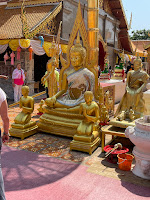3/3-3/5/2024
Today we end our short stay in Cambodia and ride back to the airport for a flight from Siem Reap to Bangkok, with a connecting flight to Thailand’s northern city of Chiang Mai.
 |
| Buddhas at the airport |
 |
| Capt. Larry gets "leied" |
After breakfast with David and Linda, we went to the resort’s parking area to meet up with the Four Seasons’ pair of resident water buffalo. One of the animals is pink (albino), and they are brought out each morning to delight the guests.
 |
| The "pink" water buffalo |
 |
| Jane and friend |
After we arrive at the camp, we are asked to change into elephant-print clothing “so the elephants don’t mistake you for food and eat you.”
 |
| Group pic |
But since everyone knows that elephants are herbivores, we suspect that this is to protect our clothing or have everyone dressed alike to benefit group photos.
 |
| Getting a dust bath |
A staff member gives us some background information about the important role elephants have played in Thai culture and about the unique relationship elephants have with their mahout handlers. We go to a corral, which the elephants have been brought into, and are given instructions on how to feed the animals. We are given bags of chopped sugarcane, and we feed, pet, and interact with the elephants until the cane is gone. The mahouts lead the animals to a stream, which they enter to bathe.
 |
| Tod & Jane make a vitamin ball |
We follow and are invited to join the elephants and help them bathe by scrubbing them with stiff brushes. Apparently, it’s something they like. We declined the invitation after seeing one mahout throw elephant poop out of the water. Next, we go to a pavilion and are instructed on how to make and feed vitamin balls, which supplement the elephants’ diet. We line up in front of a row of elephants for a farewell group photo.
 |
| Bathing the elephants |
Unknown to us, the mahouts have buckets of water, which the elephants suck into their trunks and spray on us as the photo is being made. We shower, change back into our clothes, and enjoy a box lunch before leaving the sanctuary.
Before returning to our hotel, we visit a nearby hill tribe village. The term “hill tribe” is used in Thailand for all the various ethnic groups who mostly inhabit the high mountainous northern and western regions of Thailand—the border regions with Laos and Myanmar (Burma).
 |
| A "hill tribe" woman |
 |
| Hill tribe village "wooden" couple |
Upon entering the village, we find women of different ethnic groups trying to sell their wares and handicrafts to the tourists. Although the different groups come together to make a living, they are by no means really integrated. Each group maintains its own culture, traditions, and language, even though they share the territory in which they live with other groups.
 |
| Mother & daughter "long necks" |
 |
| Temple in Doi Suthep complex |
The rings or coils can elongate the neck to a length of about 15 inches. One of the women handed us a coil, and it was surprisingly heavy. We returned to our hotel and enjoyed another rare, relaxing afternoon before having dinner with David and Linda.
One of the highlights at the start of each day on trips like this is the wide selection of fresh fruits available at the breakfast buffet. Although the selection is likely to vary according to the hotel’s locality, we have enjoyed some common and not-so-common varieties, including: watermelon, cantaloupe, dragon fruit, guava, rose apple, passionfruit, bananas (often more than one kind), mango, papaya, rambutan, pima, and pineapple.
 |
| Ornate gong in complex |
We finish our breakfast with David and Linda and board a bus that will take us on a tour of Chiang Mai.
As we enter the city, our guide notes that there are 117 Buddhist temples within the city district, some dating back to the 13th century.
 |
| White Elephant shrine |
We rode a very steep, winding, mountainous road to a height of over 3500 feet to visit the Wat Phra That Doi Suthep temple, commonly referred to as “Doi Suthep.”
 |
| Ornate temple and shrines |
 |
| Replating the stupa |
 |
| Lots of Buddhas! |
There are shrines and monuments at every turn, and the artistry and architecture are quite compelling. We visit the shrine of the White Elephant and admire the ornate workmanship of several holy pagodas and Buddha statues.
 |
| More images to see |
 |
| A monk on his cell phone |
 |
| The last one! |
 |
| A dinner sunset |

No comments:
Post a Comment